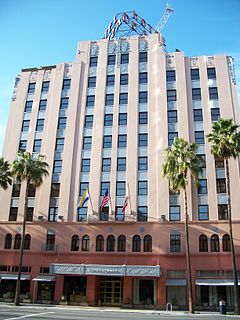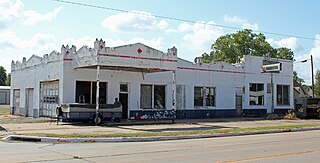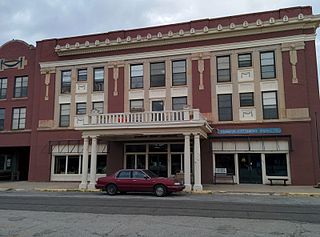
A motel, also known as motor hotel or motor lodge, is a hotel designed for motorists, usually having each room entered directly from the parking area for motor vehicles rather than through a central lobby. Entering dictionaries after World War II, the word motel, coined as a contraction of "motor hotel", originates from the Milestone Mo-Tel of San Luis Obispo, California, which was built in 1925. The term referred to a type of hotel consisting of a single building of connected rooms whose doors faced a parking lot and in some circumstances, a common area or a series of small cabins with common parking. Motels are often individually owned, though motel chains do exist.

Mapes Hotel was a hotel and casino located in Downtown Reno, Nevada, next to the Truckee River on Virginia Street. It was built in 1947 and opened on December 17 of that year. It was the first skyscraper built in the Western United States since the start of World War II. Built in a distinctive Art Deco style, the hotel was a unique high-rise built to combine a hotel and casino, providing the prototype for modern hotel/casinos.
U.S. Route 66 is a former east–west United States Numbered Highway, running from Santa Monica, California to Chicago, Illinois. In Missouri, the highway ran from downtown St. Louis at the Mississippi River to the Kansas state line west of Joplin. The highway was originally Route 14 from St. Louis to Joplin and Route 1F from Joplin to Kansas. It underwent two major realignments and several lesser realignments in the cities of St. Louis, Springfield, and Joplin. Current highways covering several miles of the former highway include Route 100, Route 366, Route 266, Route 96, and Route 66. Interstate 44 (I-44) approximates much of US 66 between St. Louis and Springfield.
The historic U.S. Route 66, also known as the Will Rogers Highway after Oklahoma native Will Rogers, ran from west to northeast across the state of Oklahoma, along the path now taken by Interstate 40 (I-40) and State Highway 66 (SH-66). It passed through Oklahoma City, Tulsa, and many smaller communities. West of the Oklahoma City area, it has been largely replaced by I-40; the few independent portions that are still state-maintained are now I-40 Business. However, from Oklahoma City northeast to Kansas, the bypassing I-44 is mostly a toll road, and SH-66 remains as a free alternate.

The Hotel De Anza is a historic hotel in San Jose, California. At ten stories, it once was the tallest hotel in the San Jose central business district, prior to the construction of Hilton, Fairmont, and Marriott hotels. Significant for its architectural style, it is one of San Jose's few Zig Zag Moderne buildings. The hotel was listed on the National Register of Historic Places on January 21, 1982.

Ambler's Texaco Gas Station, also known as Becker's Marathon Gas Station, is a historic filling station located at the intersection of Old U.S. Route 66 and Illinois Route 17 in the village of Dwight, Illinois, United States. The station has been identified as the longest operating gas station along Route 66; it dispensed fuel for 66 continuous years until 1999. The station is a good example of a domestic style gas station and derives its most common names from ownership stints by two different men. North of the station is an extant outbuilding that once operated as a commercial icehouse. Ambler's was the subject of major restoration work from 2005–2007, and reopened as a Route 66 visitor's center in May 2007. It was added to the U.S. National Register of Historic Places in 2001.

The U-Drop Inn, also known as Tower Station and U-Drop Inn and Tower Café, was built in 1936 in Shamrock, Texas along the historic Route 66 highway. Inspired by the image of a nail stuck in soil, the building was designed by J. C. Berry. An unusual example of art deco architecture applied to a gas station and restaurant, the building features two flared towers with geometric detailing, curvilinear massing, glazed ceramic tile walls, and neon light accents. It has traditionally held two separate business: "Tower Station," a gas station on the western side, and the "U-Drop Inn," a café on the eastern side. Though it has passed hands several times in its history, the building has consistently housed the same types of businesses it was originally constructed for.

The Cass Park Historic District is a historic district in Midtown Detroit, Michigan, consisting of 25 buildings along the streets of Temple, Ledyard, and 2nd, surrounding Cass Park. It was listed on the National Register of Historic Places in 2005 and designated a city of Detroit historic district in 2016.

Ottawa Street Power Station is a former municipal electric and steam utility generating station for the Lansing Board of Water and Light in Lansing, Michigan, located on the Grand River in the city's central business district that was redeveloped as corporate headquarters for the Accident Fund Insurance Company of America.

Moderne architecture, also sometimes referred to as "Style Moderne" or simply "Moderne", describes certain styles of architecture popular from 1925 through the 1940s.

The Boots Motel, a historic U.S. Route 66 motor hotel in Carthage, Missouri, opened in 1939 as the Boots Court at 107 S. Garrison Avenue.

The Minnesota Building is a historic office building in Saint Paul, Minnesota, United States. The structure was placed on the National Register of Historic Places (NRHP) on June 10, 2009. The building was noted for its design, which was a harbinger for the transition from Classical architecture to the Art Deco/Moderne among commercial buildings in downtown Saint Paul; originally designed in a conservative style, the building became more Moderne as it was being built.

The Young Brothers Chevrolet Garage is a site on the National Register of Historic Places located in Chinook, Montana. It has also been known as AAA Garage, as Taylor Motor Company, as Tilleman Chevrolet, and as Precision Auto Body. It was added to the Register on August 16, 1994. It is a stucco building with an asphalt roof.

The former Reno Main Post Office, located at 50 S. Virginia St. in Reno, Nevada, was built in 1933. The post office was designed by noted Nevada architect Frederic J. DeLongchamps and was built by the MacDonald Engineering Co., of Chicago, at cost of $363,660. This building was listed on the National Register of Historic Places in 1990. as U.S. Post Office-Reno Main.

The Sayre Champlin Service Station is a historic service station located on old U.S. Route 66 in Sayre, Oklahoma. The station, an affiliate of the Champlin Refining Company, was built in 1934; it replaced an older station which predated Route 66. Its main building has a Streamline Moderne design which features oval pilasters and horizontal sections, plate glass and multi-light windows, and a contrasting color scheme. The station provided both gasoline and automobile services to Route 66 travelers; in addition, the large tanker trucks used to supply the station's gasoline contributed to the highway's traffic. After Interstate 40 bypassed Route 66 in 1958, business at the station declined, and it closed permanently in 1967.

The Canute Service Station is a historic service station located along former U.S. Route 66 in Canute, Oklahoma. The service station was built in two sections; the western section opened in 1936 as a roadhouse, while the service station itself was added in 1939. The station was designed in the Pueblo Deco style, an architectural style which blended elements of the Art Deco and Pueblo Revival styles. The Pueblo Deco style was most popular in the Southwest, particularly among businesses on Route 66 looking to attract westbound travelers. The service station's Pueblo Deco elements include its stucco exterior, its castellated parapet decorated with tile diamonds, and its red tile roof.

The Jackson Conoco Service Station is a one-story brick structure located in El Reno, Oklahoma. Listed on the National Register of Historic Places in 2004, it was constructed by the Continental Oil Company in 1934 as a service station to serve the increasing automobile traffic along Route 66. Conoco built and operated many such facilities in the 1930s, all identical except for the positioning of the service bay; one other example is listed on the NRHP in Oklahoma, the Spraker Service Station in Vinita.

The Southern Hotel is a three-story Classical Revival structure located in El Reno, Oklahoma. Listed on the National Register of Historic Places in 1978, the building was constructed in 1909 as a hotel for passengers traveling the Rock Island Railroad as well as travelers along the Oklahoma Railway Company's interurban line to Oklahoma City. When it was built, the Southern Hotel was one of the most opulent and extravagant hotels in Oklahoma.

















